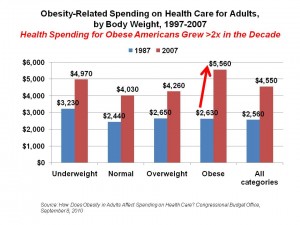 Most folks living in the U.S. are overweight or obese. In the 20 years between 1987 and 2007, the proportion of overweight people grew from 44% to 63% — and the percentage of obese adults doubled from 13% to 28%.
Most folks living in the U.S. are overweight or obese. In the 20 years between 1987 and 2007, the proportion of overweight people grew from 44% to 63% — and the percentage of obese adults doubled from 13% to 28%.
As the chart illustrates, health care costs more than doubled for obese people, as well. This represents health spending on conditions like diabetes, coronary heart disease, and hypertension.
In How Does Obesity in Adults Affect Spending on Health Care? the Congressional Budget Office (CBO) analyzes the, if you’ll excuse the expression, growth of the nation’s body-mass index (BMI) over time, and relates the BMI to health spending.
The gap between health spending on people of normal weight compared with obesity health citizens is huge: 8% in 1987, and 38% in 2007. This chasm, CBO found, is due to the availability of expensive treatments that focus on the conditions of obesity: heart, diabetes, bariatric surgeries, etc. CBO says that one-half of this spending gap is due to treating obesity-related diseases.
Health Populi’s Hot Points: CBO’s report concludes on a gloomy note: that once a person reaches the level of obesity, it is very hard to change both eating and exercise behaviors. Even when a dramatic weight loss occurs, maintaining a healthy weight is mighty difficult and continued intervention is usually required. This, then, adds another kind of cost into the equation, so that even when someone might achieve a healthy weight, they may add costs to the health system in terms of longevity (the sort of “good news, bad news” kind of cost) as well as needing supportive ‘nudging’ to keep the weight off — which results in more costs to the health system.
The obesity economy will therefore be a major line item in the nation’s macroeconomy that will be a component of America’s health spending for some time — even in the sunniest fiscal scenarios built by the CBO in this report.




 I'm in amazing company here with other #digitalhealth innovators, thinkers and doers. Thank you to Cristian Cortez Fernandez and Zallud for this recognition; I'm grateful.
I'm in amazing company here with other #digitalhealth innovators, thinkers and doers. Thank you to Cristian Cortez Fernandez and Zallud for this recognition; I'm grateful. Jane was named as a member of the AHIP 2024 Advisory Board, joining some valued colleagues to prepare for the challenges and opportunities facing health plans, systems, and other industry stakeholders.
Jane was named as a member of the AHIP 2024 Advisory Board, joining some valued colleagues to prepare for the challenges and opportunities facing health plans, systems, and other industry stakeholders.  Join Jane at AHIP's annual meeting in Las Vegas: I'll be speaking, moderating a panel, and providing thought leadership on health consumers and bolstering equity, empowerment, and self-care.
Join Jane at AHIP's annual meeting in Las Vegas: I'll be speaking, moderating a panel, and providing thought leadership on health consumers and bolstering equity, empowerment, and self-care.